
GRADISCA D'ISONZO
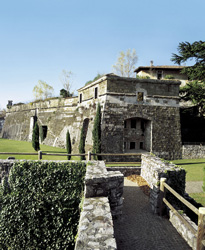 Set between the Isonzo river and the Collio area, Gradisca faces the Friuli
plain westwards. Today, the town can be considered as a wealthy “country lady”
who recalls history and past fortunes, enjoying life at the relaxed pace learned
in former times.
Set between the Isonzo river and the Collio area, Gradisca faces the Friuli
plain westwards. Today, the town can be considered as a wealthy “country lady”
who recalls history and past fortunes, enjoying life at the relaxed pace learned
in former times. 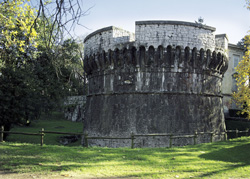 Considered a “daughter of Venice”, Gradisca d’Isonzo was fortified at the
end of the 1500s, to defend itself from the Turkish invasions. In the following
century it became part of the Hapsburg Empire and by the Great War it became
“capital” of the Capitanato, i.e. a territory including a large plain area
which belonged to eastern Friuli. Between the 1600s and the 1700s it was a
principality ruled by the Eggenberg family. It was then allowed to coin its
own currency as well as to vote at the Emperial assembly. At that time, it
was known as “Principata Imperiale Contea di Gradisca”, and later almost forgotten
during the quiet Hapsburg government.
Considered a “daughter of Venice”, Gradisca d’Isonzo was fortified at the
end of the 1500s, to defend itself from the Turkish invasions. In the following
century it became part of the Hapsburg Empire and by the Great War it became
“capital” of the Capitanato, i.e. a territory including a large plain area
which belonged to eastern Friuli. Between the 1600s and the 1700s it was a
principality ruled by the Eggenberg family. It was then allowed to coin its
own currency as well as to vote at the Emperial assembly. At that time, it
was known as “Principata Imperiale Contea di Gradisca”, and later almost forgotten
during the quiet Hapsburg government. 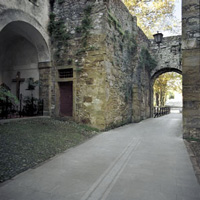 Tourists should not miss a visit to Gradisca, whose present urban structure
and many of its monuments reflect the dominion of the High Serene Venetian
Republic which was overshadowed by the predominant presence of the Hapsburg
Empire. A remarkable example is given by the ancient defensive walls and its
towers (even Leonardo da Vinci was asked for his advice). Other remarkable
places are the Cathedral, the town museum, the museum of ancient stone tablets,
the Merchants’ Loggia, the Monte di Pietà the house of the Venetian
provosts, the buildings named after the Torriani, de Fin-Patuna and Strassoldo-Pace-de-Carnelli-Mistruzzi
families.
Tourists should not miss a visit to Gradisca, whose present urban structure
and many of its monuments reflect the dominion of the High Serene Venetian
Republic which was overshadowed by the predominant presence of the Hapsburg
Empire. A remarkable example is given by the ancient defensive walls and its
towers (even Leonardo da Vinci was asked for his advice). Other remarkable
places are the Cathedral, the town museum, the museum of ancient stone tablets,
the Merchants’ Loggia, the Monte di Pietà the house of the Venetian
provosts, the buildings named after the Torriani, de Fin-Patuna and Strassoldo-Pace-de-Carnelli-Mistruzzi
families. 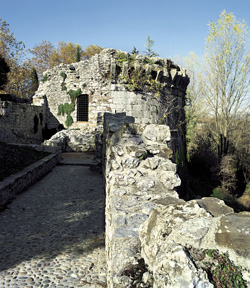 However, not only the ancient heritage of Gradisca is worth a visit today.
As a matter of fact, a remarkable example of contemporary art is given by
the regional art gallery “Luigi Spazzapan” (phone number 0481960816, free
entrance, closed on Monday), which features an important collection of paintings
by Luigi Spazzapan. It was formerly owned by Eugenio Giletti, an art collector
from Turin. At present, it belongs to the Cassa di risparmio di Gorizia. The
collection consists of about fifty paintings such as oil and tempera paintings
and drawings dating from 1928 to 1956, which represent the artistic career
of the painter, who was a good friend of the sculpteur Umberto Mastroianni.
The gallery also houses a permanent collection featuring paintings by Altieri,
Spacal, Pizzinato, Alviani, Ciussi, Mocchiutti, Miela Reina, Zigaina, Mirko
and Afro Basaldella.
However, not only the ancient heritage of Gradisca is worth a visit today.
As a matter of fact, a remarkable example of contemporary art is given by
the regional art gallery “Luigi Spazzapan” (phone number 0481960816, free
entrance, closed on Monday), which features an important collection of paintings
by Luigi Spazzapan. It was formerly owned by Eugenio Giletti, an art collector
from Turin. At present, it belongs to the Cassa di risparmio di Gorizia. The
collection consists of about fifty paintings such as oil and tempera paintings
and drawings dating from 1928 to 1956, which represent the artistic career
of the painter, who was a good friend of the sculpteur Umberto Mastroianni.
The gallery also houses a permanent collection featuring paintings by Altieri,
Spacal, Pizzinato, Alviani, Ciussi, Mocchiutti, Miela Reina, Zigaina, Mirko
and Afro Basaldella. In conclusion, we wish to highlight another “art”, which is at the same time modern and refined, which is represented by the wine cellar “La Serenissima” , located in the building of the Provveditori Veneti (Veneto Superintendents). The best two hundred white and red wines are collected and sold in this place, from a selection awarded each year with the Noè prize. The wine from Friuli Venezia Giulia is selected by sommeliers and wine experts after rigorous tests: the winning wine acts as ambassador for the good quality of the wines in this region for the whole year.
“La Serenissima”: a permanent regional wine celler.
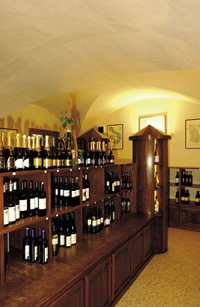 The town of Gradisca features the Palazzo dei Provveditori veneti (Venetian
provosts), which covers an area of over 1,000 square metres. Francesco Ten,
who ruled the town from 1481 to 1486, designed the bauilding. It is characterized
by cross vaults and it was restored in 1989. Since 1965, it has hosted the
regional wine cellar “La Serenissima”, which is managed by ERSA (the regional
authority for the promotion and development of agricultural activities in
Friuli Venezia Giulia). Its rooms contain frescoes by Fred Pittino depicting
rural scenes, and are used for exhibitions and the tastings of many regional
wines. Perfect combinations of wines, local dishes and a variety of produce
is presented to the many visitors.
The town of Gradisca features the Palazzo dei Provveditori veneti (Venetian
provosts), which covers an area of over 1,000 square metres. Francesco Ten,
who ruled the town from 1481 to 1486, designed the bauilding. It is characterized
by cross vaults and it was restored in 1989. Since 1965, it has hosted the
regional wine cellar “La Serenissima”, which is managed by ERSA (the regional
authority for the promotion and development of agricultural activities in
Friuli Venezia Giulia). Its rooms contain frescoes by Fred Pittino depicting
rural scenes, and are used for exhibitions and the tastings of many regional
wines. Perfect combinations of wines, local dishes and a variety of produce
is presented to the many visitors. 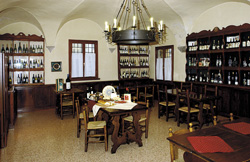 This wine cellar is a comprehensive and interesting shop window for those
who wish to learn more about local products, their historical background,
their links with tradition and the local area. A wide range of about three
hundred wines is precisely selected by wine experts.
This wine cellar is a comprehensive and interesting shop window for those
who wish to learn more about local products, their historical background,
their links with tradition and the local area. A wide range of about three
hundred wines is precisely selected by wine experts. Over six hundred bottlers attend the annual competition which is named Grandi vini Noè (great wines of Noah) in honour of the biblical culture. The aim of the competition is to carefully choose the best regional wines, include them in the produce list of the wine cellar and promote them at home as well as abroad. Promotions start with the official opening of the competition during the second half of May. On this occasion many other minor exhibitions are held, for instance, the exhibition of grappa and spumante (sparkling wine), the tasting of D.O.P. (Protected Denomination of Origin) produce and of traditional produce. Rural production sites, wine cellars, vineyards and other places of local historical interest, attract visitors.
